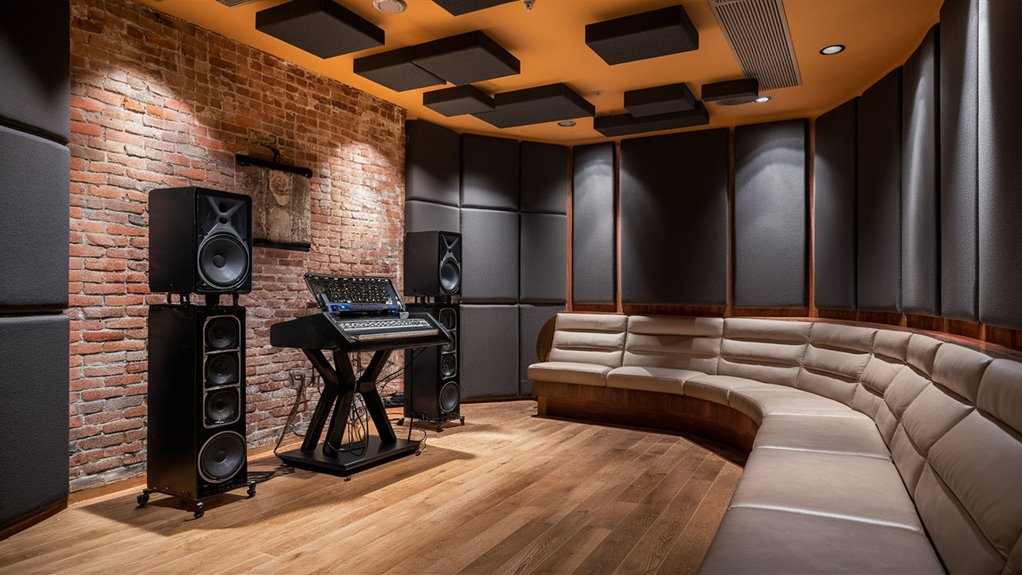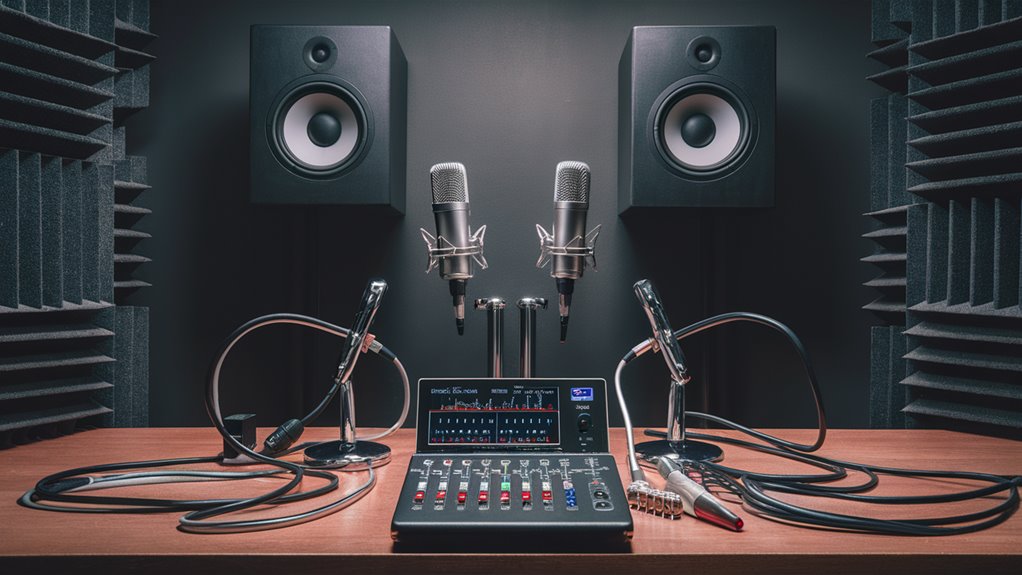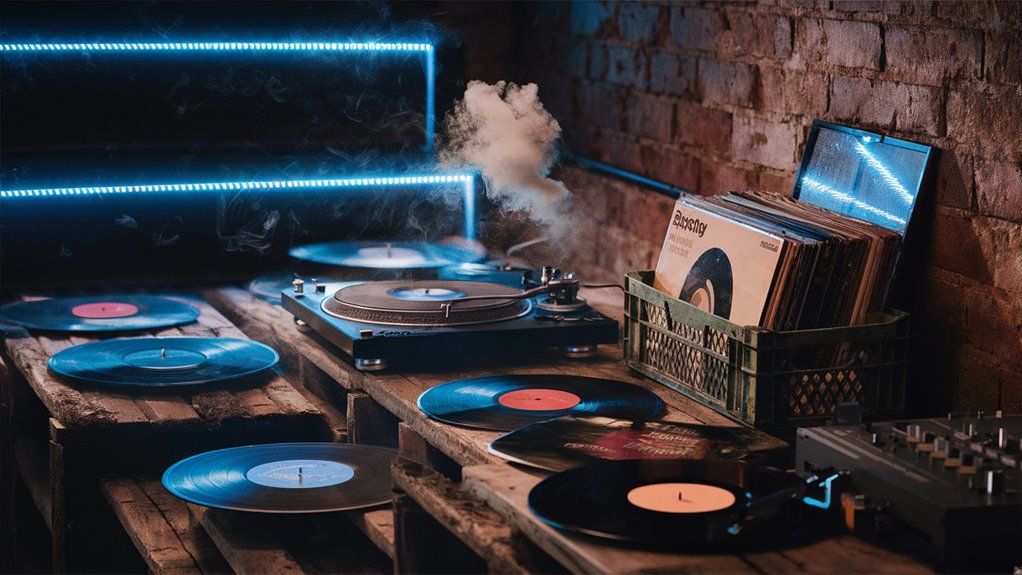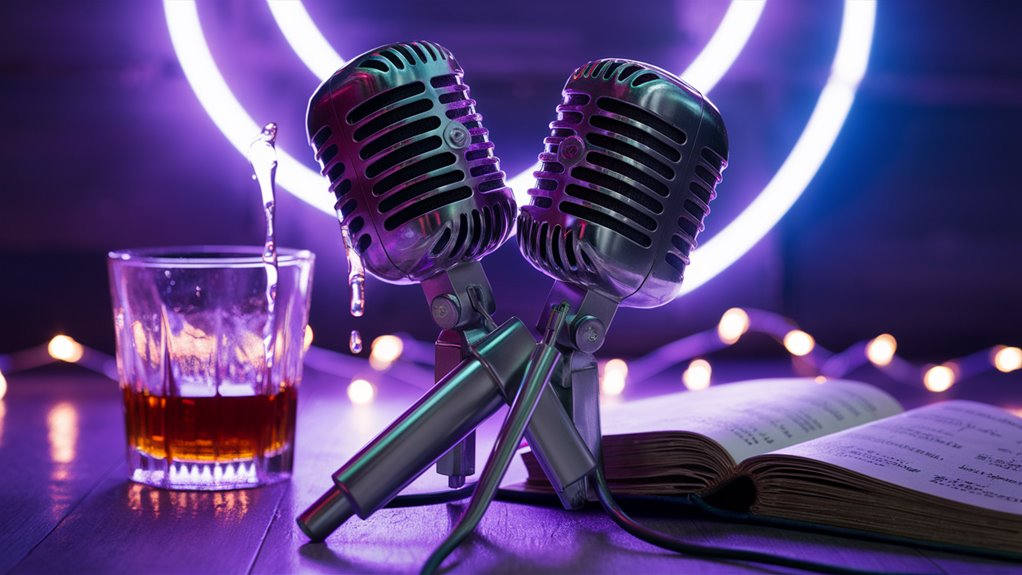Help with Pro Karaoke Machine Set Up

Tech Key Points
When setting up a pro karaoke kit, watch the tech parts well. Begin with an amp with 150W per channel for best form. Use great speakers that have 90dB+ touch to make sounds very clear.
Speaker Placement and Sound Fine-tuning
Set your main speakers just right:
- Turn them 60 degrees from the center
- Lift speakers 1.5-2 meters off the ground
- Put speakers 2-3 meters apart
- Adjust mic input gain from -6dB to -12dB
Care for Sound Level
Set your sound mix with these steps:
- Set song levels to -3dB
- Keep a song-to-voice mix at 70:30
- Use mics that handle 130dB SPL
Sound Fixes for Place
Make your space sound better by:
- Put up sound fixes on 30% of your wall
- Aim for the right RT60 of 0.8-1.2 seconds
- Mix how sound bounces and soaks up
- Cut out bad sound rings
This will lock in great sound feel and make your karaoke spot better.
Key Karaoke Gear Guide
Must-Have Tools
A top karaoke set needs five key parts: a karaoke source, amp, strong speakers, great mics, and a display screen.
Each part must hit set tech goals for the best feel.
Pro Sound Gear Specs
At the heart of any good karaoke set is a pro mixer-amp giving at least 150W per channel.
Must have built-in Digital Signal Work (DSP) and smart ring cut. Pro speakers must hit:
- 90dB+ touch grade
- 90° wide angle
- 60° tall angle
- Running Smoothly
- At least 100W RMS power use
Mic and Wire Needs
Dynamic heart mics are key for pro karaoke setups, with:
- 130dB SPL ability
- -70dB touch
- 50Hz-15kHz sound reach
- XLR links with gold tips
- Pure copper wires
Show and Pics Tools
High-def display setups must have:
- At least 40-inch screen
- 1080p high-def ability
- HDMI or mix video links
- Best view from 10-15 feet
Back-Up and Safety Tools
Needed back-up parts include:
- Extra mic heads
- Right fuses for the kit
- Strong Power Supply (UPS) at 1.5x total use
Room Sound and Set-Up: Key Guide for Karaoke Tune-Up
Sound Fixes Needed
Right sound fixes and smart gear spots make sure your karaoke set does its best.
Room sound shifts how the sound hits, clears the voice, and the whole user feel.
Check and Manage Echo
Room echo time (RT60) should be 0.8-1.2 seconds for top form.
Put up sound panels on about 30% of walls, aiming at main bounce spots.
Find these spots using the mirror trick – see where the sound from speakers bounces from where people sit.
Smart Speaker Spots
Speaker spots need smart picks:
- Place main parts 3-4 feet from walls
- Mount speakers at ear level (5-6 feet up)
- Turn speakers 30-45 degrees towards the crowd
- Keep screens and mics at least 6 feet apart
- Cut rings by pointing screens away from mics
Best Sing Spot
Make a main sing sweet spot 8-10 feet from main speakers. This right spot brings:
- Clear screen levels for singers
- Great sound for the crowd
- Even sound spread
- Low ring trouble
- Strong voice throw
Top Guide to Speaker Spots for Karaoke Sets
Must-Spot Rules for Speakers
Right speaker spots make the perfect karaoke space.
Place main speakers at a sharp 60-degree turn from the sing area, put them up 1.5 to 2 meters from the floor.
Speakers should be tipped down at a 10-15 degree slant for max sound spread and to keep sound rings low.
Make the Best Two-Sided Sound
To get a top two-sided sound, keep even speaker spots from the sing area, space 2-3 meters apart between speakers.
Monitor speakers need a sharp 45-degree turn towards the singer, put 1-1.5 meters from the sing spot, making a clear zone that doesn’t mess with main speaker work.
New Spot Ideas
Keep at least 30cm space between speakers and walls to keep bass build-up low.
For sets with subwoofers, place them on the floor near the main speakers, within a 1-meter zone to match sound phases.
In big rooms over 6 meters wide, use time-spread speakers in the middle of the room, with time tuning at 1.1 milliseconds per foot from the main setup.
Pro Mic Picks and Tests Help

Pick the Right Mic Specs
Dynamic mics with heart-shaped sound spots are best for pro karaoke, cutting rings and making voices clear.
The best sound range is 50Hz to 15kHz, catching all voice types well.
Tech Needs and Matching
Low match (150-600 ohms) between mics and sound boost tools is best for true sound.
Key touch grades (-50 to -54 dB) show how mics deal with different voice strength.
Watch for top SPL abilities over 130 dB for clear sound at high voice levels.
Test Steps
Smooth Sound Path
Stage gain at -18 dB space in mixer paths for best sound flow.
Test battery power stays key for mic add-ons.
Test plans check near sound reply at more than one place to keep voice steady.
Check Points
Total sound-to-noise tests over many voice levels show if mics work as hoped.
Check for sound when held and look closely at sound play info to set sound levels for each mic spot.
Test many spots to make sure even cover and sound boost all over the sing area.
Full Guide to Sound Mix and Levels
Pro Sound Gain Care
Sound mixing and level setting start with the right setup of your sound set’s signal way.
Put mic input gain between -6dB and -12dB for the best sound-to-noise mix and to cut sound rings.
All song tracks should be set to -3dB for even play form.
Key Sound Range Setting
Sound range care is key for top sound feel.
Set your low-end cross at 100Hz to cut voice mud.
Center the mid-range sound at 2.5kHz to raise voice clearness and feel.
Set the top-end shelf over 8kHz for top shine while stopping harsh s sounds.
Top Output Sound Care
Watch your main output levels using digital play, keeping peaks under 0dB.
Get a pro sound mix with a song-to-voice mix of 70:30.
Put watch speakers 3-6dB under the main mix to cut ring issues.
Use voice press with a 4:1 mix and a -18dB edge for even sound levels.
Adjust these parts as needed based on your room’s sound parts and set response.
Pro Sound Set Fix Help
Sound Way Checks
Begin your fix steps with a set sound way test using a 1kHz sound tone at -18dB.
Follow the sound way with care from source parts to speakers, checking levels at all links to find possible breaks or sound match issues in the set.
Ring Care
Fix ring issues with a live sound tool (RTA) to pin down problem sound zones.
Make needed fixes with a 31-band sound leveler, dropping bad sounds by -3dB to -6dB.
For sets with on and off sound issues, do deep wire tests with a link checker while making sure good ground split.
Voice Lift and Set Tune-Up
Watch mic sound play over the key 100Hz to 10kHz zone for best voice clearness.
Set press edge to -12dB with a 4:1 mix to keep sound flow even.
For digital sound sets, make sure A/D change rates match play tools.
Check speaker way using phase tools and test load levels to keep amps safe.
If you find sound breaks, use scope tests to see if issues start before or after power boost.
Must-Have Gear List
- Sound tone tool
- Live sound tool
- 31-band sound leveler
- Link checker
- Phase tool
- 호치민 퍼블릭가라오케
- Scope
- Load level checker
Pro Karaoke Gear Care Guide
Key Tech Points
Pro karaoke sets need good care for best form.
Watch output levels each week, keeping them from -18 to -12 dB for top sound feel.
Amp heat must stay under 85°F (29°C) when on to avoid harm.
Regular Clean Steps
Mixer care is key for top sound feel.
Clean sliders and round knobs with contact wash every 60 days to stop signal mix-ups.
Mic care needs monthly clean of fronts using 70% cleaning alcohol, while keeping capsule touch at -54 dB ±3 dB.
Digital Set Care
Do quarterly system refreshes to keep set trust.
Drive care should include clean-up at 75% full line.
Speaker checks need half-year sound tests, making sure 20 Hz to 20 kHz range with max ±3 dB shift.
Keep karaoke track back-ups with 128-bit code on different drives, keeping full care logs with dates and tech info.
- Fix dates and work done
- Technical checks
- Tool work levels
- Set sound tests


